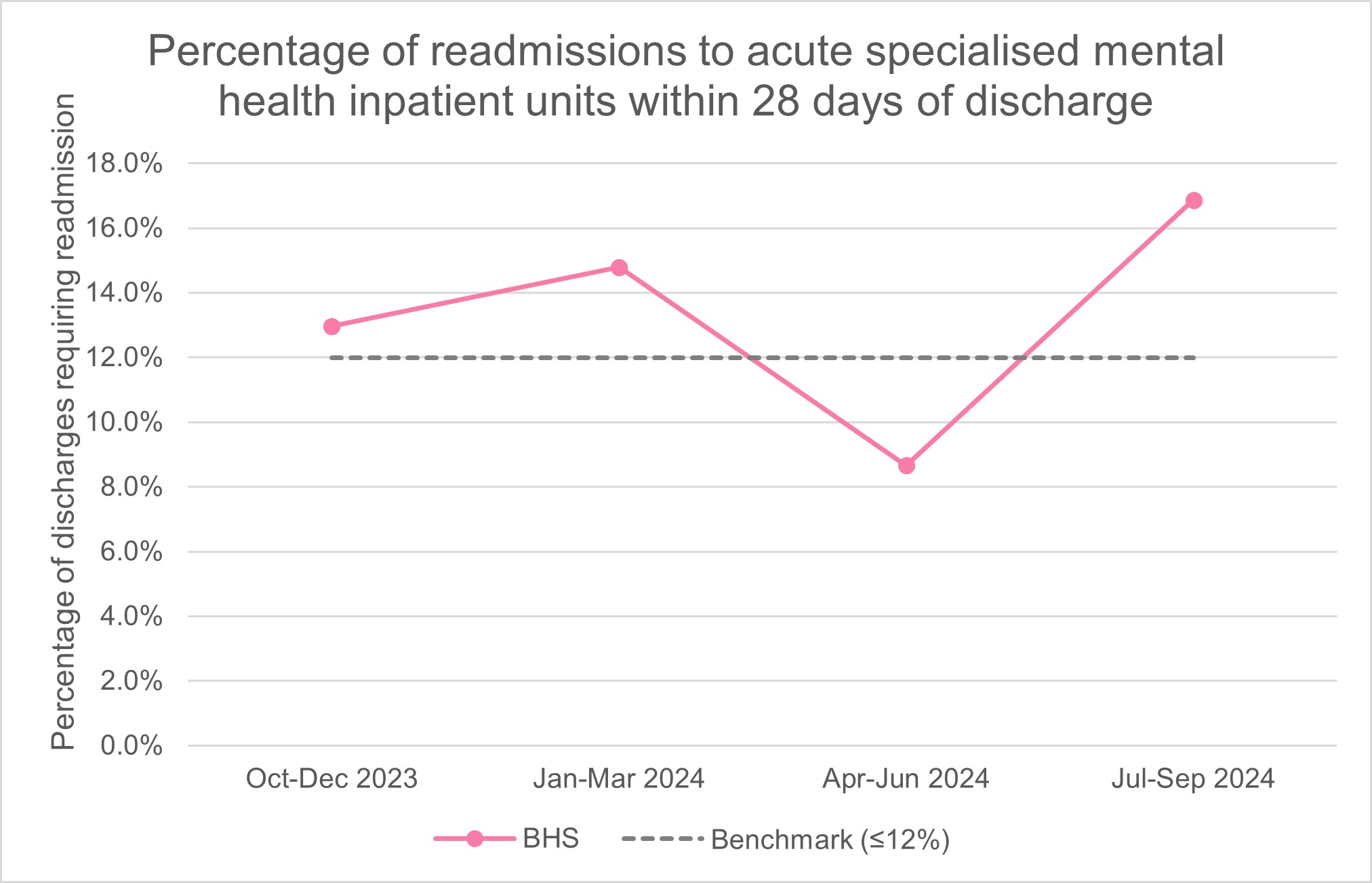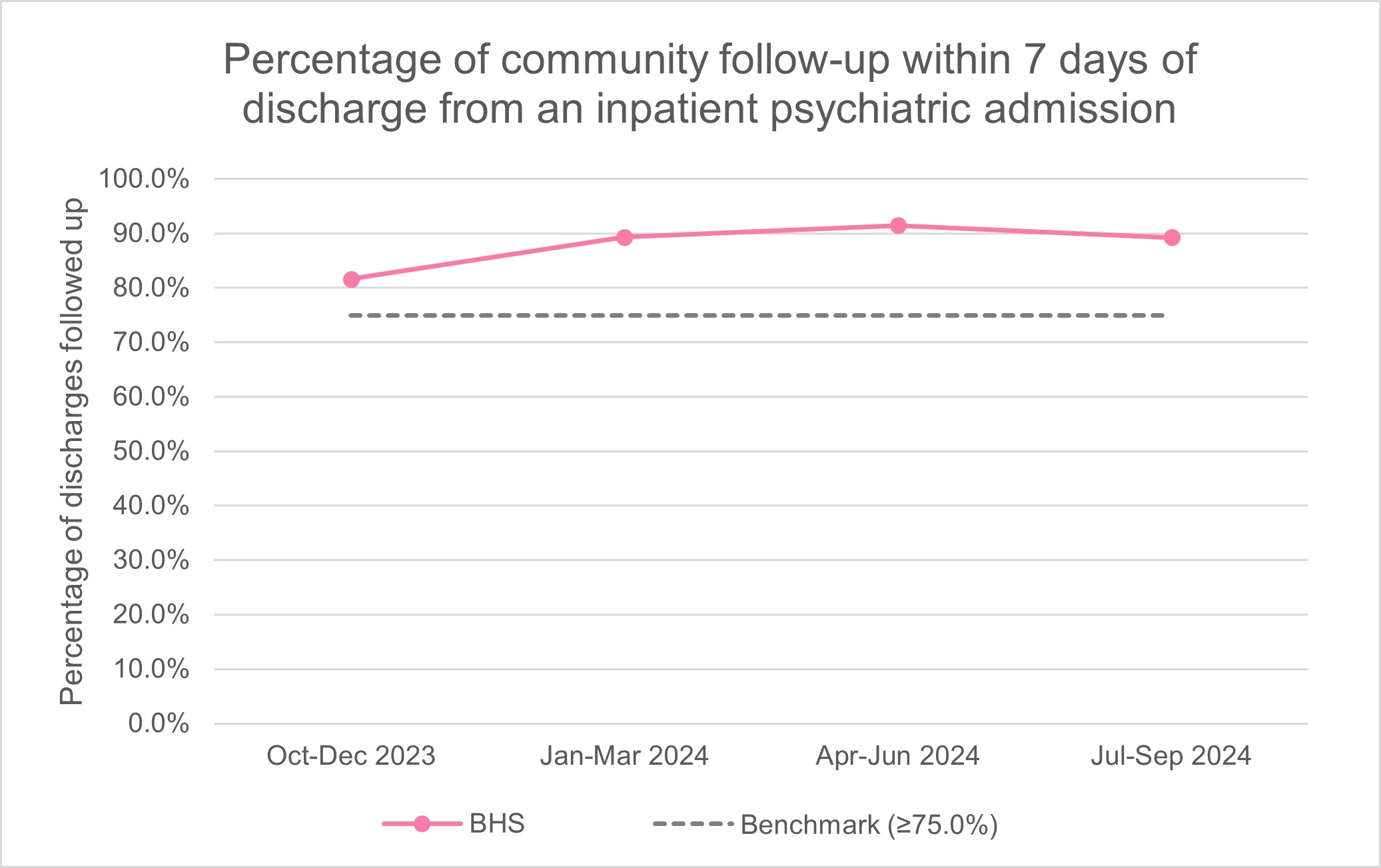Caring for Our Mental Health Clients
As part of our commitment to delivering amazing care, we are committed to ensuing our mental health clients receive the highest quality care possible.
EMHS provides both inpatient and outpatient mental health services and we are constantly looking at ways to continuously improve these services both in hospital and in the community.
The rate of readmission to hospital within 28 days of discharge is a commonly used indicator of how well a health system is performing.
For people accessing mental health services, this indicator can help health services better understand the effectiveness of the in-hospital treatment and community based follow-up care that they provide. While it is important to note that there may be other factors that influence early readmissions, such as the episodic nature of mental illness, this indicator is still considered a useful way of measuring and monitoring how well mental health services are meeting the needs of the people they care for.
Measuring readmissions to acute specialised mental health inpatient units
The period of 28 days is internationally accepted as an appropriate time period for the measurement of readmissions following discharge from an acute inpatient mental health service. This standard has been endorsed by the Australian Health Ministers' Advisory Council (AHMAC) Mental Health Information Strategy Standing Committee (as at 24 March 2011).
The benchmark for this indicator is ≤ 12% patients admitted to an acute specialised mental health inpatient unit having one or more readmissions within 28 days of discharge.
How do we measure up
The graph below shows the combined rate of readmissions to acute specialised mental health inpatient units within 28 days of discharge for Bentley Health Service.
Chart: Percentage of readmissions to acute specialised mental health inpatient unit within 28 days of discharge.

What the figures mean
The graph shows the quarterly rate of readmissions to acute specialised mental health inpatient units within 28 days of discharge for BHS. A rate lower than the benchmark is desirable. The BHS rate of readmissions to acute specialised mental health inpatient units within 28 days of discharge has been above the benchmark for three of the last four quarters. BHS aims to achieve a consistent rate of less than 12% and this is an area of ongoing review.
Discharge from hospital and transition to community-based care is a critical point for people receiving mental health care. People leaving hospital after an admission for an episode of mental illness may be more vulnerable and are at increased risk of readmission without adequate follow up. This period of transition is also a time of great stress and uncertainty for families and carers.
A responsive community support system for people who have experienced an acute psychiatric episode requiring hospitalisation is essential to maintain clinical and functional stability and to minimise the need for hospital readmission.
Community follow-up services include:
- community-based crisis assessment and treatment teams
- day programs
- mental health outpatient clinics provided by either hospital or community-based services
- child and adolescent outpatient and community teams
- social and living skills programs
- psychogeriatric assessment services
- hospital-based consultation-liaison and in-reach services to admitted patients in non-psychiatric and hospital emergency settings
- ambulatory-equivalent same day separations
- home based treatment services
- hospital based outreach services.
Service contacts are not restricted to in-person communication but can include telephone, video link or other forms of direct communication.
Measuring the rate of community follow up within the first 7 days of discharge from psychiatric admission
People who are discharged from a mental health service should have a person-to-person follow up contact within 7 days of discharge. The rate of community follow up within the first 7 days from discharge is measured for all people that are discharged following a psychiatric hospital admission.
Follow up contact is only regarded as a service contact if it is relevant to the clinical condition of the patient/client. This means that it does not include services of an administrative nature (e.g. telephone contact to schedule an appointment) except where the nature of the service would normally warrant a dated entry in the clinical record of the person in question.
In May 2011 a target of 75% achievement was endorsed by the Australian Health Ministers' Advisory Council (AHMAC) Mental Health Information Strategy Standing Committee. This target will be subject to periodic review and will be further informed by analysis of the data.
How do we measure up
The graph below shows the combined rate of community follow up within first 7 days of discharge from psychiatric admission for Bentley Health Service.
Chart: Percentage of community follow-up within seven days of discharge from psychiatric admission.

What the figures mean
The graph shows the percentage of community follow up within first 7 days of discharge from psychiatric admission by quarter for BHS. A percentage higher than the benchmark is desirable.
BHS is consistently performing better than the benchmark in all of the last four quarters.

